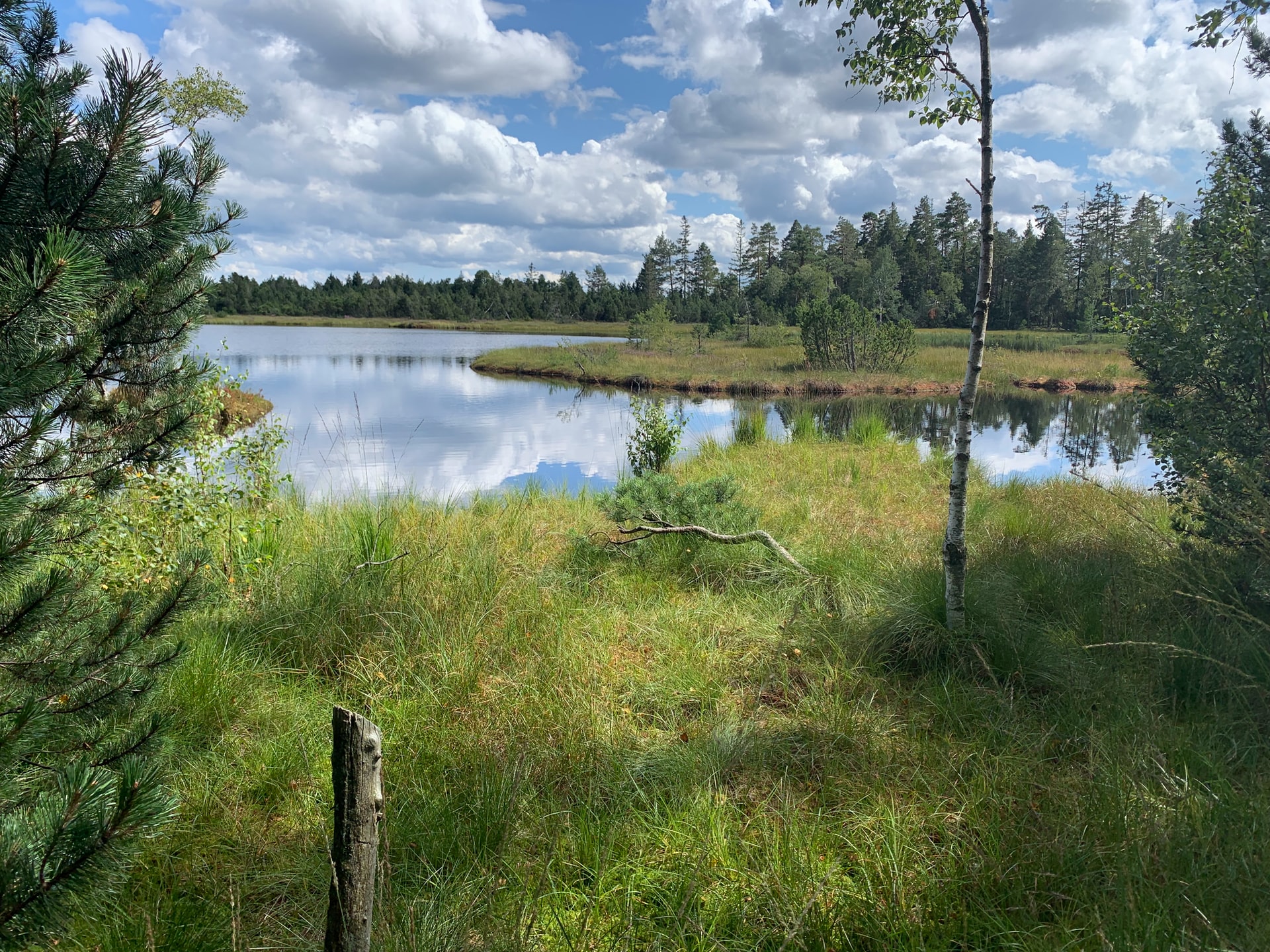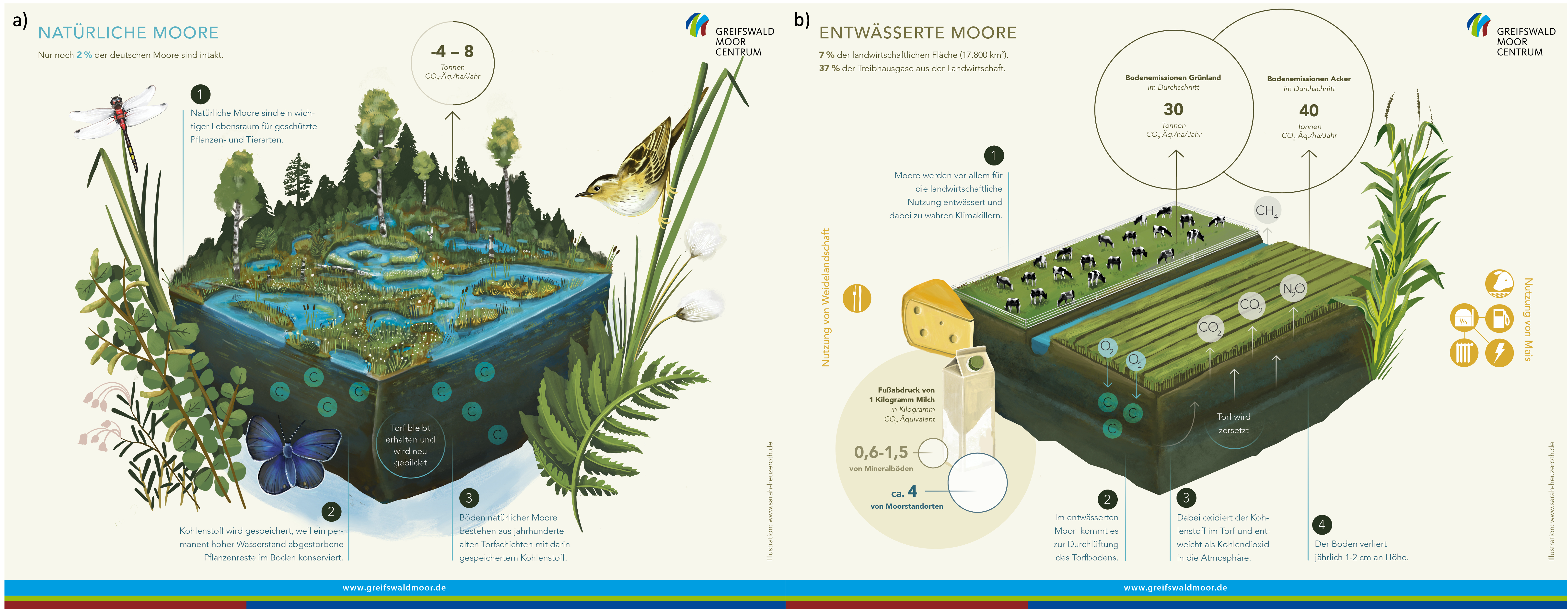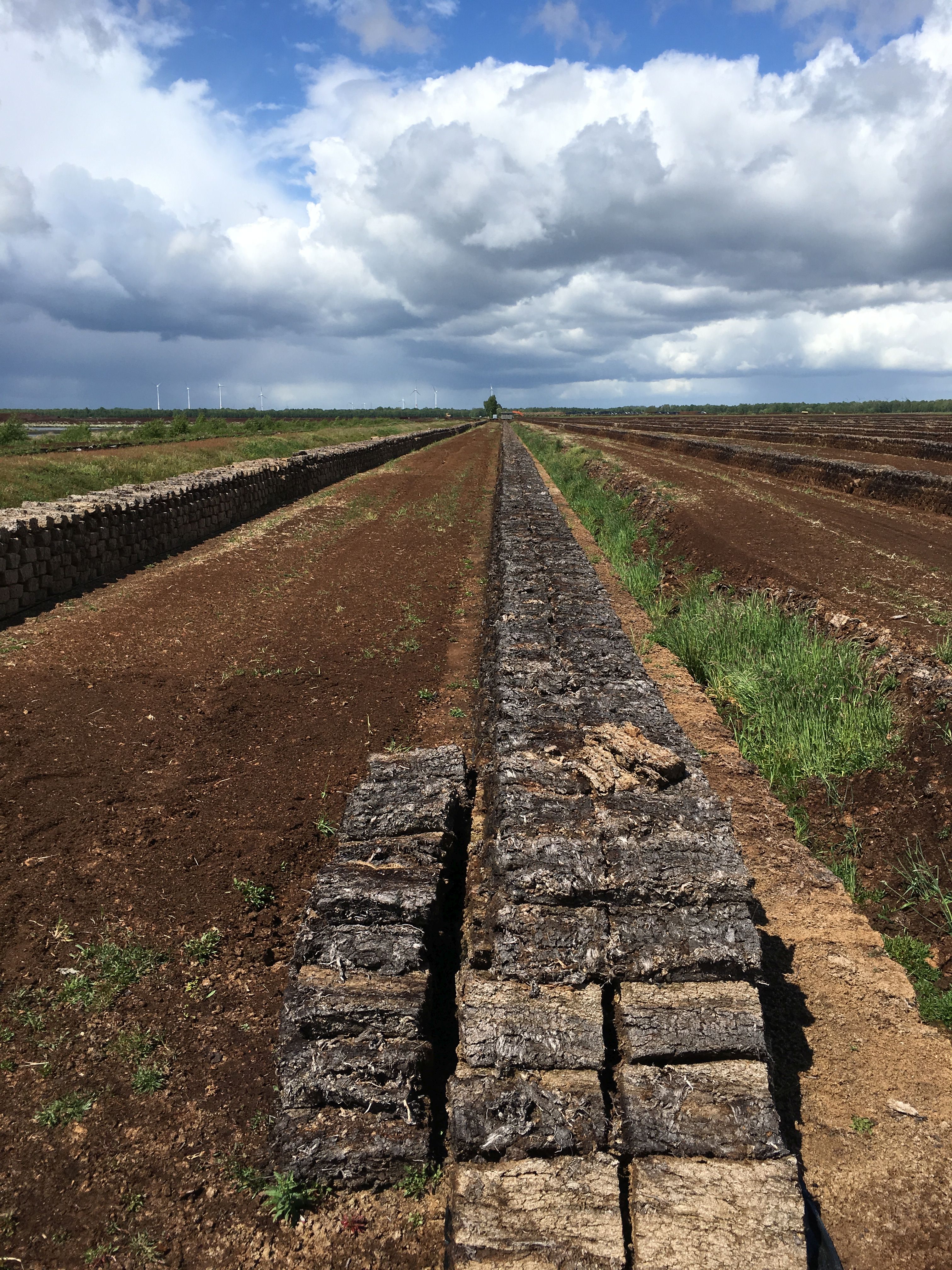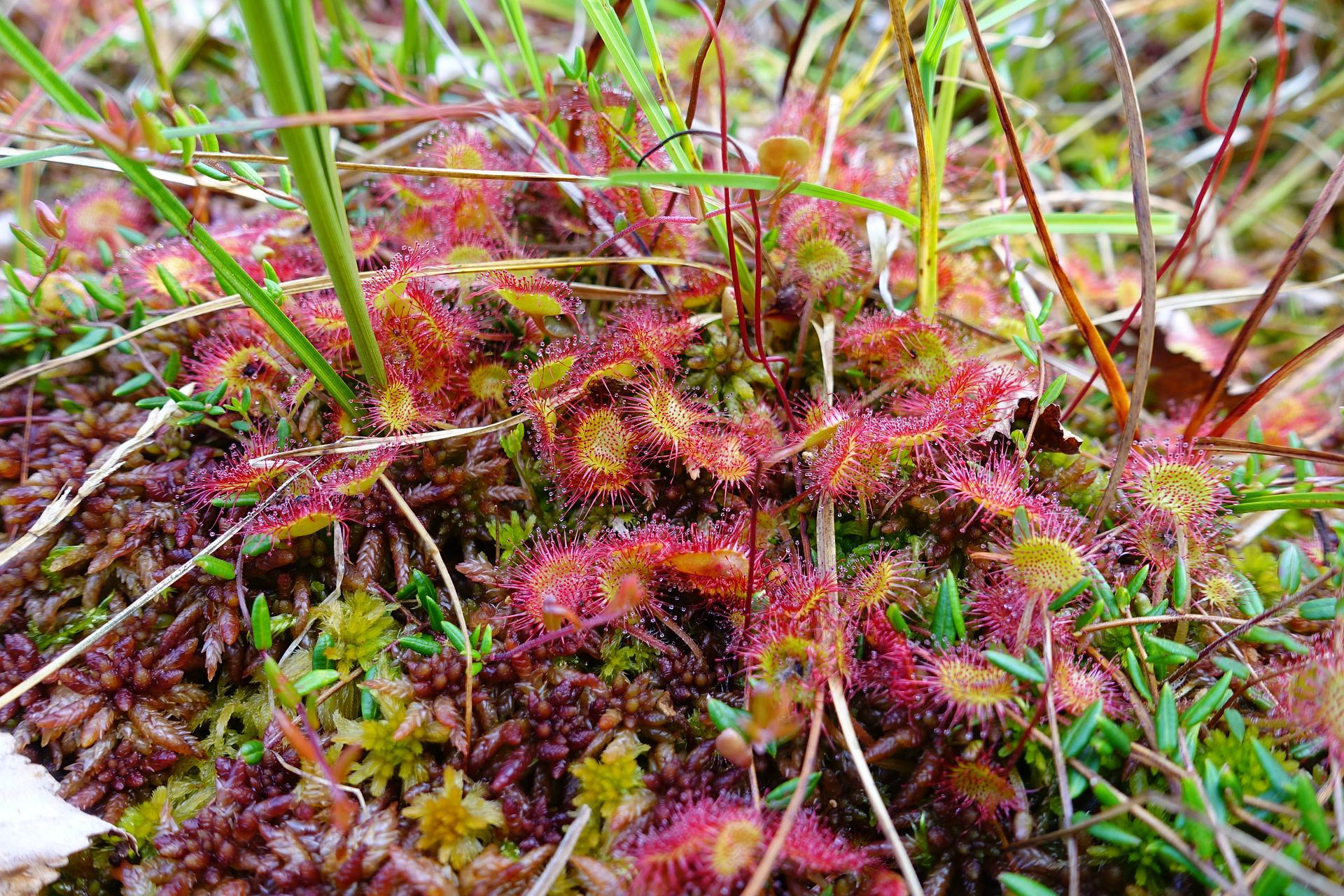Main navigation
Peatlands as a climate protection factor - binding CO2 instead of releasing it
All the intact peatlands on our planet store twice the amount of carbon dioxide as all the forests. Peatlands are indispensable for preventing and mitigating the effects of climate change. The only problem is that 95 percent of Germany's peatlands have been drained, and thus release around 7 percent of Germany’s total CO2 emissions into the atmosphere. Rewetting is therefore imperative for the climate, the environment and biodiversity – and economically promising.
We mostly tend to come across peatlands in mystical scenes from movies. The fact that degraded peatlands are responsible for 5 percent of global CO2 emissions is less well known.1) In Germany, around 7 percent of all greenhouse gas emissions come from drained peatlands, which corresponds to about 53 million tonnes of carbon dioxide equivalent per year2) - far more than the total released by German air traffic.3) The rewetting of peatlands is an important factor in the ambition to achieve climate neutrality by 2045. At the same time, biodiversity needs to be restored. The topicality of the situation is made clear not least by the German government's Peatland Protection Strategy and the awarding of the German Environmental Prize 2021 to peatland researcher Prof. Dr. Dr. Hans Joosten.
What are peatlands, and where are they found?

At the end of the Ice Age, many peatlands were formed as the glaciers melted. In principle, peatlands are formed where water does not seep away, e.g. in depressions and river lowlands. A characteristic feature of peatlands is that oxygen cannot reach the underlying layer due to water saturation. This means that the organic, dead animal and plant material is not completely decomposed: peat mosses, for example, extract CO2 from the air and convert it into plant matter. If the lower parts of a plant die, the carbon compounds remain bound in the permanent wet environment, layers of organic material accumulate and peat is formed.
Peatlands are found in almost every country, most frequently in Alaska, Canada, Western Siberia, Northern Europe, Southeast Asia and the Amazon Basin. In Germany, peatlands are found mainly in Lower Saxony, Brandenburg, Mecklenburg-Western Pomerania, Schleswig-Holstein, Bavaria and Baden-Württemberg.
Peatlands store more carbon than any other ecosystem in the world
All around the world, measures are being taken to limit the global temperature increase to 1.5 °C. What is often overlooked is that the experts on the Intergovernmental Panel on Climate Change assume in almost all scenarios that billions of tonnes of greenhouse gases will be filtered out of the atmosphere and stored.
This is where peatlands can become a beacon project: although they only cover three percent of the Earth's surface, they have sequestered around one third of terrestrial carbon: 500 gigatonnes, twice as much as in the Earth's entire forest biomass.1) Expressed in direct area comparison, the amount of carbon stored in the peat body is equivalent to six times the area of a forest. Peat can thus be called a miracle actor, because intact peat layers remove 150 - 250 million tonnes of CO2 from the world’s atmosphere every year.4)

CO2 sink becomes CO2 source
"Even though peat bogs grow very slowly, accumulating only around 1 mm of peat per year, they counteract climate change," explains Dr. Franziska Tanneberger. She is a scientist at the University of Greifswald and head of the Greifswald Mire Centre, and has been researching peatlands for over ten years, partly in cooperation with the Karlsruhe Institute of Technology and the University of Freiburg. "Unlike most other ecosystems, which only store a certain amount of carbon growing peatlands continuously remove carbon from the atmosphere and store it permanently. However, if the water level decreases, oxygen penetrates the peat, and oxidation releases CO2 as well as nitrous oxide, which is even more harmful to the climate." This thus becomes a factor that contributes to climate damage.
Methane behaves somewhat differently, as Tanneberger explains: "Methane can escape from wet bogs, for example when fresh, uncut meadows are flooded. That's why certain precautions have to be taken when rewetting pasture land." In the case of both pasture and farmland, it is important to stop active drainage by dismantling drainage systems or switching off pumps, which also consume energy. "Since peatlands originally developed in wet areas, the areas then become wet again and CO2 and nitrous oxide emissions thus stop immediately," says Tanneberger. A crucial aspect here is that while CO2 remains in the atmosphere for around a thousand years, this is reduced to around twelve years for methane.5) "Even if methane is emitted after rewetting, the climate effect is positive in the long term."
Agriculture as an important key to solving the climate crisis
Over 95 percent of Germany’s peatlands are drained.6) The reason is that more than two centuries ago, people wanted to reclaim land and therefore dug ditches to drain it. As peat obtained from dead fibres burns well, it was used as a fossil fuel – especially once industrialisation got underway.

Since the 1960s, peatland has been silted up for forestry and agricultural use. Now more than 50 percent of what was peatland is used as pasture for fodder and 20 percent as arable land for growing potatoes, carrots and energy crops.2) The crucial point: even after draining, the still moist and acidic environment is either not suitable for many plants or the yield is too low. "In Germany, drained peatlands account for just 7 percent of agricultural land and yet are responsible for 41 percent of total agricultural greenhouse gas emissions," says Tanneberger. Around 40 t of CO2 are thus released per hectare per year.5) This corresponds to the average emissions produced by driving 185,000 km in a medium-sized car.
It is now known that food produced on peat soils - whether organic or conventional - has a very large carbon footprint. The detail behind this is both frightening and revealing: "We have determined that when animals are raised on drained soils, 1 l of milk produces as many CO2 emissions as burning 2.5 l of petrol," says Tanneberger. "A first important step would be to produce food only on mineral soils. Moreover, moisture-resistant plants can be grown on peat soils for producing building materials and energy."
Another problem is the extraction of peat for use as a substrate for garden centres, fruit and vegetable cultivation and private users. Eight million tonnes of peat are still extracted annually in Germany, but due to growing environmental awareness, fewer licences are being granted. However, there are alternative sources: for example, peat is increasingly being imported from the Baltic States. Peat-free alternatives are already available for amateur gardeners. Researchers at the University of Freiburg have cultivated special peat moss plants in a bioreactor for fruit and vegetable cultivation in order to re-vegetate degraded peatlands. The special characteristic is that the peat substitute grown by the Freiburg researchers grows 50 to 100 times faster than the peat used so far in commercial cultivation. The aim is to increase awareness for something that can do even more than reduce atmospheric CO2 levels.
All-in-one: flood protection, climate regulator and biodiversity champion

Peatlands can almost be described as a fire-fighting all-rounder: thanks to their pore-rich layer structure and swelling capacity, they are effective water reservoirs. They can absorb 30 times their dry weight and help prevent flooding and flood disasters. In dry periods, peatlands in turn mitigate localised severe heatwaves through evaporation. Rewetting also reduces the risk of fire.
Peatland plants have a waxy outer layer, which absorbs pollutants and nutrients - up to 180 kg of nitrate per hectare per year - and thus purify the groundwater. In addition, peat-forming peatlands grow upwards, while drained areas sink because mineralisation of the organic matter causes a continuous loss of height, which then necessitates strategies to adapt to rising sea levels.
The semi-aquatic state is a paradise for plant and animal species, especially those that are weakly competitive. Many such species either do not occur in other habitats or are endangered. These include sundew, peat mosses, cranberries, grasses, as well as some beetle, dragonfly and bird species.
Strategies, exciting opportunities to participate - and taking farmers along
Until now, the strategy pursued by the German Federal Ministry of Food and Agriculture has only involved near-natural peatlands. However, the vast majority of greenhouse gas emissions come from peatlands used for agricultural purposes. An overarching strategy is now to be developed with the Natural Climate Protection action programme.7) According to the National Peatland Protection Strategy of the Federal Ministry for the Environment, Nature Conservation, Nuclear Safety and Consumer Protection, greenhouse gas emissions from peatland soils are to be reduced annually by five million tonnes of CO2 equivalents nationwide up to 2030.2)
The BUND describes this as a step in the right direction, but the timescale as a whole is too short. Tanneberger mentions another issue: "Agricultural businesses must be given economic support to enhance their prospects and enable transformation. The farming of drained land does not generate particularly high yields, so the profit from this land is far lower than the subsidies available. New framework conditions need to be created here." On the positive side, there are many ways in which peatlands can be used profitably; from cultivating wetland to keeping resistant animal breeds and developing innovative markets.
The long-term goal is to renaturalise all raised bogs in the state that are capable of regeneration. Baar10), a large-scale nature conservation project, involves optimising rewetting measures in the Plattenmoos and the Schwenninger Moos peatland areas, among others, while the ‘Natur Westliches Allgäu’ project network, begun in 2021, is promoting renaturation.
Companies and institutions have also recognised the opportunity arising from peatlands and are providing support through renaturing work or the purchase of CO2 certificates.11) Project participation for the rewetting and economic use of wet peatlands is also made possible by the initiative toMOORow12) implemented by the Michael Otto Environmental Foundation and the Michael Succow Foundation.
Every hectare of renaturalised peatland saves around 10 t of CO2 annually, roughly the same as each of us produces on average per year. Knowing this can be inspirational.
1) IPPC Report Climate Change and Land (2019), p. 397. https://www.ipcc.ch/site/assets/uploads/2019/11/SRCCL-Full-Report-Compiled-191128.pdf
2) National Peatland Strategy, Federal Ministry for the Environment, Nature Conservation, Nuclear Safety and Consumer Protection, 01.09.2021. https://www.bmuv.de/fileadmin/Daten_BMU/Download_PDF/Naturschutz/nationale_moorschutz_strategie_bf.pdf
3) Figures from 2017: 31.2 mio.. t CO2, including 2.1 mio. t caused by domestic flights. Federal Environment Agency: Umweltschonender Luftverkehr 130/2019, p. 29. https://www.umweltbundesamt.de/sites/default/files/medien/1410/publikationen/2019-11-06_texte-130-2019_umweltschonender_luftverkehr_0.pdf
4) Federal Agency for Nature Conservation: Klimaschutz - Moore als Kohlenstoffspeicher und THG-Quelle. https://www.bfn.de/oekosystemleistungen-0#anchor-3817
5) Hirschelmann et al. (2020): Faktensammlung "Moore in Mecklenburg-Vorpommern im Kontext nationaler und internationaler Klimaschutzziele – Zustand und Entwicklungspotenzial". https://greifswaldmoor.de/files/dokumente/GMC%20Schriften/2020-03_Moore%20in%20MV_Faktensammlung_%20Hirschelmann%20et%20al_final.pdf
6) Greifswald Mire Centre, https://www.moorwissen.de/de/moore/tools/moore_deutschland.php); NABU (https://www.nabu.de/natur-und-landschaft/moore/deutschland/16345.html
7) Natura Climate Protection Action Programme. https://www.bmuv.de/pressemitteilung/bundesumweltministerin-steffi-lemke-stellt-eckpunkte-fuer-aktionsprogramm-natuerlicher-klimaschutz-vor (29.3.2022).
8) Baden-Württemberg Peatland Protection Programme. https://um.baden-wuerttemberg.de/fileadmin/redaktion/m-um/intern/Dateien/Dokumente/2_Presse_und_Service/Publikationen/Umwelt/Naturschutz/Moorschutzprogramm_BW.pdf
9) Baden-Württemberg funding programme: Moorschutzkonzeption. https://um.baden-wuerttemberg.de/de/umwelt-natur/naturschutz/instrumente-des-naturschutzes/foerderung/moorschutzkonzeption/
10) Baar (large-scale conservation project). https://www.ngp-baar.de/
11) Peatland protection: Peatland certificates as voluntary compensation measures for CO2 emissions caused privately or commercially. https://www.aktion-moorschutz.de/moor-infos/moor-zertifikate.html); MoorFutures (https://www.moorfutures.de/news/interview-mit-klaus-philipp-felderer-ceo-felderer-ag/
12) toMOORow initiave - Michael Otto Evironmental Foundation. https://www.tomoorow.org